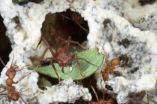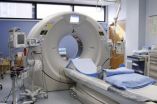(Press-News.org) (Embargoed) CHAPEL HILL, N.C. – Using a combination of genetic engineering and laser technology, researchers at the University of North Carolina at Chapel Hill have manipulated brain wiring responsible for reward-seeking behaviors, such as drug addiction. The work, conducted in rodent models, is the first to directly demonstrate the role of these specific connections in controlling behavior.
The UNC study, published online on June 29, 2011, by the journal Nature, uses a cutting-edge technique called "optogenetics" to tweak the microcircuitry of the brain and then assess how those changes impact behavior. The findings suggest that therapeutics targeting the path between two critical brain regions, namely the amygdala and the nucleus accumbens, represent potential treatments for addiction and other neuropsychiatric diseases.
"For most clinical disorders we knew that one region or another in the brain was important, however until now we didn't have the tools to directly study the connections between those regions," said senior study author Garret D. Stuber, PhD, assistant professor in the departments of cell and molecular physiology, psychiatry and the Neuroscience Center in UNC School of Medicine. "Our ability to perform this level of sophistication in neural circuit manipulation will likely to lead to the discovery of molecular players perturbed during neuropsychiatric illnesses."
Because the brain is comprised of diverse regions, cell types and connections in a compact space, pinpointing which entity is responsible for what function can be quite tricky. In the past, researchers have tried to get a glimpse into the inner workings of the brain using electrical stimulation or drugs, but those techniques couldn't quickly and specifically change only one type of cell or one type of connection. But optogenetics, a technique that emerged six years ago, can.
In the technique, scientists transfer light-sensitive proteins called "opsins" – derived from algae or bacteria that need light to grow – into the mammalian brain cells they wish to study. Then they shine laser beams onto the genetically manipulated brain cells, either exciting or blocking their activity with millisecond precision.
In Stuber's initial experiments, the target was the nerve cells connecting two separate brain regions associated with reward, the amygdala and the nucleus accumbens. The researchers used light to activate the connections between these regions, essentially "rewarding" the mice with laser stimulations for performing the mundane task of poking their nose into a hole in their cage. They found that the opsin treated mice quickly learned to "nosepoke" in order to receive stimulation of the neural pathway. In comparison, the genetically untouched control mice never caught onto the task.
Then Stuber and his colleagues wanted to see whether this brain wiring had a role in more natural behavioral processes. So they trained mice to associate a cue – a light bulb in the cage turning on – to a reward of sugar water. This time the opsin that the researchers transferred into the brains of their rodent subjects was one that would shut down the activity of neural connections in response to light. As they delivered the simple cue to the control mice, they also blocked the neuronal activity in the genetically altered mice. The control mice quickly began responding to the cue by licking the sugar-producing vessel in anticipation, whereas the treated mice did not give the same response.
The researchers are now exploring how changes to this segment of brain wiring can either make an animal sensitized to or oblivious to rewards. Stuber says their approach presents an incredibly useful tool for studying basic brain function, and could one day provide a powerful alternative to electrical stimulation or pharmacotherapy for neuropsychiatric illnesses like Parkinson's disease.
"For late-stage Parkinson's disease it has become more routine to use deep brain stimulation, where electrodes are chronically implanted into brain tissue, constantly stimulating the tissue to alleviate some of the disease symptoms," said Stuber. "From the technical perspective, implanting our optical fibers is not going to be more difficult than that. But there is quite a bit of work to be done before we get to that point."
INFORMATION:
The research was funded by NARSAD: The Brain & Behavior Research Fund; ABMRF/ The Foundation for Alcohol Research; The Foundation of Hope; and the National Institute on Drug Abuse, a component of NIH.
Study co-authors from Stuber's laboratory at UNC include Dennis R. Sparta, PhD, postdoctoral fellow, and Alice M. Stamatakis, graduate student.
Scientists use 'optogenetics' to control reward-seeking behavior
2011-06-30
ELSE PRESS RELEASES FROM THIS DATE:
Scientists shed light on the private lives of electrons
2011-06-30
A Princeton researcher and his international collaborators have used lasers to peek into the complex relationship between a single electron and its environment, a breakthrough that could aid the development of quantum computers.
The technique reveals how an isolated electron and its surroundings develop a relationship known as a Kondo state – a state of matter that is of great interest to physicists and engineers. The results not only yield insights into a long-standing quandary in theoretical physics, but also may help scientists understand how to store information at ...
At-HomeMedSpa.com Announces Addition of "La Roche-Posay" Brand to Their Online Product Catalog
2011-06-30
www.At-HomeMedSpa.com has announced the addition of the La-Roche-Posay line, to their online store. La Roche-Posay is famous for using thermal spring water rich in selenium. La Roche-Posay is an internationally known line of skincare sold all over Europe, Asia, Latin America, and now it is available at At-HomeMedSpa in the United States! The unique thermal spring water comes from a small village in central France called La Roche-Posay, which is where the brand's name is derived from.
La Roche-Posay Thermal Spring Water is the result of rainwater flowing over vast expanses ...
Fungus farming ant genome reveals insight into adaptation of social behavior
2011-06-30
June 30, 2011 – The development of agriculture was a significant event in human cultural evolution, but we are not the only organisms to have adopted an agricultural way of life. In a study published online today in Genome Research (www.genome.org), researchers have sequenced the genome of a fungus farming leaf-cutting ant, revealing new insights into the genetics and molecular biology behind this unusual lifestyle.
Found in Central and South America as well as the southern United States, leaf-cutting ants have evolved a symbiotic relationship with fungus. By breaking ...
Study shows 20 percent reduction in lung cancer mortality with low-dose CT vs chest X-ray
2011-06-30
Scientists have found a 20 percent reduction in deaths from lung cancer among current or former heavy smokers who were screened with low-dose helical computed tomography (CT) versus those screened by chest X-ray. The primary research results from the National Lung Screening Trial (NLST) were published online today in the New England Journal of Medicine.
This article provides a more extensive analysis of the data originally reported in November 2010 while providing additional data to the public and research community without barriers to access. Sponsored by the National ...
Joe Jedlowski Makes Significant Donation to Alzheimer's Association
2011-06-30
Joe Jedlowski is pleased to announce a significant donation made to the Alzheimer's Association. This donation will help in many aspects when it comes to research and treatment of this detrimental disease. Joe Jedlowski, who is a prominent executive throughout the senior living field, has firsthand knowledge of the effects that Alzheimers has on individuals and their families.
As Regional Vice President of Atria Senior Living Group, Joe was affiliated with many influential groups and organizations within the New Jersey community. In addition to monetary donations, he ...
The Cancer Genome Atlas completes detailed ovarian cancer analysis
2011-06-30
An analysis of genomic changes in ovarian cancer has provided the most comprehensive and integrated view of cancer genes for any cancer type to date. Ovarian serous adenocarcinoma tumors from 500 patients were examined by The Cancer Genome Atlas (TCGA) Research Network and analyses are reported in the June 30, 2011, issue of Nature.
Serous adenocarcinoma is the most prevalent form of ovarian cancer, accounting for about 85 percent of all ovarian cancer deaths. TCGA researchers completed whole-exome sequencing, which examines the protein-coding regions of the genome, ...
Mr. Dimitri Snowden Announces the Launch of His Personal New Website
2011-06-30
Dimitri Snowden announces the launch of his new website, www.DimitriSnowden.com. The site will be a virtual hub, showcasing Dimitri's online activities and linking his business and personal pursuits in one easy to find location. The new website details Dimitri Snowden's passion for mixed martial arts (MMA), robotics, racing, the environment, and his strategic consulting firm, ion360. The consulting firm specializes in delivering compelling outcomes using clever strategy and smart technology platforms.
The newly-launched website states that Dimitri Snowden, within the ...
Lung cancer screening trial shows screening with CT scans reduces lung cancer deaths
2011-06-30
Philadelphia — Results of the National Lung Screening Trial (NLST) published online in the June 30 New England Journal of Medicine report a twenty percent reduction in lung cancer deaths among study participants who were screened with low-dose helical computed tomography (CT) versus those screened with chest X-ray. Conducted by the American College of Radiology Imaging Network (ACRIN) and the National Cancer Institute's Lung Screening Study Group, the NLST enrolled 53,000 current and former heavy smokers aged 55 to 74 at 33 sites across the United States.
Lung cancer ...
UCSF-led team decodes evolution of skin and ovarian cancer cells
2011-06-30
A team of researchers led by scientists at the University of California, San Francisco has developed a way to uncover the evolution of human cancer cells, determining the order in which mutations emerge in them as they wend their way from a normal, healthy state into invasive, malignant masses.
The work may give doctors a new way to design diagnostics for detecting the signs of early cancers, when they are generally more treatable than in their later stages.
This approach relies on teasing apart the DNA of cancer cells, and it is something like genetic archeology. ...
Betting on good luck and 4-leaf clovers
2011-06-30
Research led by the University of Cambridge has found a link between impulsivity and flawed reasoning (such as believing in superstitious rituals and luck) in problem gamblers.
Studying compulsive gamblers who were seeking treatment at the National Problem Gambling Clinic, the researchers found that those gamblers with higher levels of impulsivity were much more susceptible to errors in reasoning associated with gambling, such as superstitious rituals (e.g. carrying a lucky charm) and explaining away recent losses (e.g. on bad luck or 'cold' machines).
The findings ...




